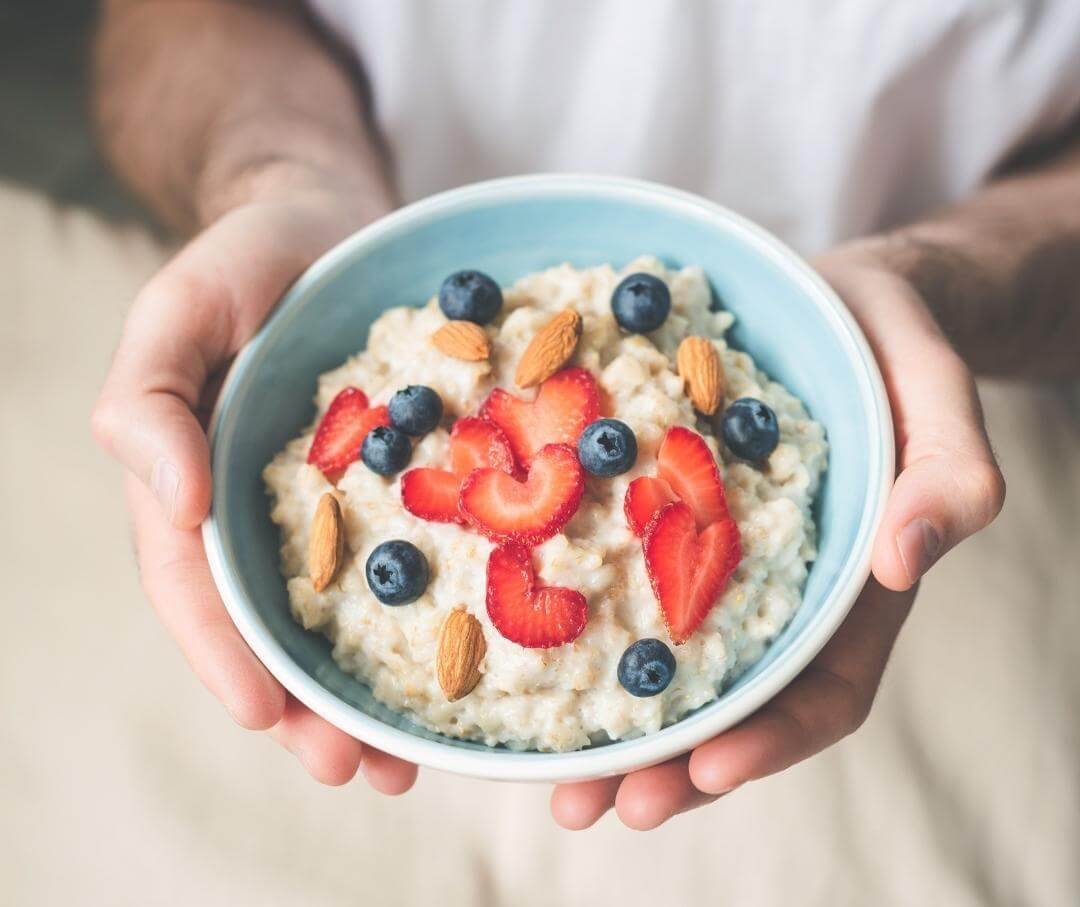A woman is considered in menopause after one year of no menstrual cycles (periods), typically between 45 and 55 years old.1
However, there is a period before that in which the body undergoes hormone changes as they transition to menopause, called perimenopause.
A woman could be impacted by drastic hormonal changes for ten years, which also affects their metabolism, their risk for future health conditions, and overall health.1
Keep reading to learn about women’s health, menopause and your diet, what food to eat and avoid, and tips for managing menopause symptoms.
{{mid-cta}}
Understanding Menopause
Menopause (stopping of periods and fertility) occurs due to estrogen and progesterone decline. During perimenopause, these hormones are fluctuating.
Estrogen assists with improved blood sugar levels, bone health and density maintenance, and increased metabolism.
Every woman is impacted differently, but as estrogen levels decline, women observe weight gain and increased risk of health conditions like insulin resistance, type 2 diabetes, and osteoporosis.1
Most women (75-80%) experience side effects like hot flashes, night sweats, headaches, and joint pain due to declining hormone levels. Up to 30% of women experience severe versions of these side effects.1
Lifestyle and diet changes can alleviate these side effects, making life more manageable during the transition and preventing future health problems.
The Impact of Food on Menopause Symptoms

The average woman enters perimenopause and menopause in a compromised state: 40% of women are carrying excess weight, most are consuming higher fat diets, consuming very few fruits and vegetables, and inadequate calcium intake.1
The combined effect of declining hormone levels and existing lifestyle and eating habits can increase the risk of heart disease, type 2 diabetes, and osteoporosis (low bone strength).
Making dietary changes during perimenopause and menopause can offset the hormonal changes, reduce menopause symptoms, and prevent chronic health conditions.
One study showed how excess weight makes menopause side effects like hot flashes worse. Losing around 11 pounds (if overweight or obese) improves hot flashes by 30%.1
8 Foods to Eat During Menopause
Here are eight foods to eat during menopause to reduce the intensity of menopause side effects, prevent health problems, and feel your best.
1. Healthy Fats
Heart disease risk increases as estrogen levels decline. Choosing healthy fats (unsaturated) like olive or avocado oil for cooking and dressings, a daily serving of nuts, and two to three servings of fish (salmon, mackerel, sardines, and tuna) weekly reduces your risk of heart disease.1
In a 2020 review, higher omega-3 fatty acid levels were associated with better health among women in postmenopause. It was also found that women in post-menopause who live with diabetes or coronary heart disease have lower omega-3 levels than women without these conditions.13
2. Fruits
Consuming fruit provides vitamins, minerals, antioxidants, a natural sweet flavor, and filling fiber. Fiber helps keep you full between meals and can help you lose excess weight.1
Aiming for 30 grams of fiber daily can help prevent heart disease. Choosing fruit can also help you reduce your added sugar intake, which is associated with type 2 diabetes and heart disease.1
Also, a 2020 study found that women who ate more fruits and vegetables experienced fewer menopausal symptoms than women who ate less of these food groups.12
3. Vegetables
Vegetables help manage weight due to their fiber content. Additionally, consuming high amounts of vegetables is heart and diabetes protective.1
Research indicates cruciferous vegetables may help reduce night sweats and hot flashes due to the compound glucosinolates.2
Cruciferous vegetables include cauliflower, broccoli, bok choy, turnip, and mustard greens. Aim for half your plate to be filled with all types of vegetables.
4. Dairy
Osteoporosis develops throughout life. Bones are built until age thirty, and bone loss occurs slowly after that until menopause.1
Estrogen levels decline rapidly in menopause, leading to an accelerated loss of bone mass. Lone bone mass increases the risk of fractures. Diet and lifestyle changes can further reduce bone loss.1
Dairy products are a good source of calcium, magnesium, and vitamin D, which are both essential for bone health. Opt for lower-fat versions, such as skim milk, Greek yogurt, low-fat yogurt, kefir, and low-fat cheese.
Alternative dairy sources like soy or almond milk are fortified with vitamin D and calcium. It is recommended to consume 1,200 mg of calcium daily.1
5. Whole Grains
Replacing refined, low-fiber grains with high-fiber whole grains reduces the risk of heart disease and diabetes.1
Try oatmeal, whole-wheat bread, quinoa, and brown rice. These whole grains are higher in fiber and help keep you full between meals. One-quarter of your plate is an adequate serving size per meal.
6. Protein
Protein helps with bone preservation, muscle mass, and feeling full between meals. As hormones change, muscle mass decreases, and fat mass increases. Fueling your body with protein at each meal can help combat these changes.1 General guidelines recommend eating 1-2 grams of protein per kilogram of body weight.14
An easy way to ensure you are consuming enough protein is to aim for one-quarter of your plate to be filled with a lean protein source like chicken, fish, turkey, or occasional lean red meat. If you are a vegan or vegetarian, quality plant-based protein sources include tofu, dairy, lentils, and beans.
Protein sources can work double duty, providing heart-healthy fats when choosing salmon or tuna.1
7. Phytoestrogen Foods
Phytoestrogens are estrogen-like compounds from plant foods that can reduce the side effects due to declining estrogen levels.3
Phytoestrogens also reduce cholesterol levels, improve heart function, maintain healthy blood sugar levels, and help with weight loss.
These plant compounds are isoflavones, stilbene, and lignan. Isoflavones are found in soy products and other legumes. Stilbenes (or resveratrol) are found in grapes and peanuts. Lignans are in ground flaxseed, chickpeas, wheat flour, peanuts, fruit, berries, vegetables, tea, and coffee.3
8. Soy
Soy products contain isoflavones, the most abundant source of phytoestrogen. These compounds work well in the menopausal environment to reduce symptoms in most women.3
Opt for the food form as it is more available for use in the body than supplements.3
Some food forms of soy include edamame, soy flour, tofu, and soy milk. Soy works extra duty, providing isoflavones, calcium, vitamin D, and protein, all helpful during menopause.
What Foods Should You Avoid During Menopause?

Focusing on what foods to include in your diet is helpful. As you fill your diet with beneficial foods, you will have less room and opportunity for foods that will exacerbate your menopausal side effects and future health conditions.
Here is a list of six foods to avoid or limit during perimenopause and menopause.
1. Processed Foods
A large review article from 2021 linked high intakes of processed foods with a 39% increased risk of carrying significant extra weight and a 79% increased risk of metabolic syndrome (a group of health conditions that increases the risk for type 2 diabetes and heart disease).4
Processed foods are generally higher in fat, sodium, and added sugar and low in vitamins, minerals, and fiber. Examples include packaged baked goods, snack foods, sugary breakfast cereal, ready-to-eat meals, and frozen meals.
2. Foods and Drinks With Added Sugar
If you enter menopause with extra weight, you may already have a harder time managing weight and blood sugar levels.
Eating foods and drinks with added sugar will worsen an already diminished ability to regulate blood sugar levels.5
High-sugar products are digested rapidly, leading to elevated blood sugar levels, weight gain, and increased risk for health conditions like type 2 diabetes and heart disease.5
Reduce or eliminate your intake of sugar-sweetened beverages, such as regular soda, fruit or sports drinks, sweetened coffee, tea, and water.
High-sugar foods include sugary breakfast cereal, candy, donuts, pastries, and desserts.
3. Refined Low-Fiber Carbohydrates
Refined grains and carbs are associated with an increased risk for type 2 diabetes and heart disease, among other health conditions.
Most people consume over half of their diet from carbohydrates, often refined carbohydrates.6
Refined carbohydrates include all sugar-sweetened beverages, snack foods, chips, white breads and flour, cakes, crackers, and many cereals.
Replacing refined carbohydrates with whole grains, beans, legumes, fruits, and vegetables provides your body with beneficial carbohydrate sources.
4. Alcohol
Light to moderate alcohol intake may reduce the risk of heart disease in post-menopausal women as it increases the estrogen levels in the blood. Light alcohol intake is less than one drink daily, whereas moderate intake is one to two drinks.7
However, alcohol intake can exacerbate hot flashes and night sweats in women. The effect was noticed predominantly in women drinking more than three drinks weekly or when drinking one to two drinks or more each day.8
Consider reducing or avoiding alcohol to see if your symptoms improve.
Some alcoholic beverages are higher in sugar and can make it more challenging to manage blood sugar levels and weight.
5. Caffeine
Research is mixed regarding caffeine intake and hot flashes or night sweats.
Some research correlates higher caffeine intake with increased symptoms, whereas others report fewer symptoms.9, 10
If you notice an increase in the frequency or severity of hot flashes or night sweats, experiment with removing caffeine and see how your body responds.
Consider lower-sugar options if your caffeine is sugar-loaded (sweetened coffee or soda).
6. Spicy Foods
Limited research exists on spicy food and hot flashes, which makes sense as spicy food can increase one's body temperature.
A study from 2021 on women in Lebanon links spicy food intake with increased rates of hot flashes.11
As with caffeine and alcohol, pay attention to your menopause symptoms after spicy foods. Eliminating these foods and beverages may help, but you may find no improvement and could continue incorporating these if you enjoy them.
<p class="pro-tip"><strong>Learn More: </strong><a href=is-spicy-food-good-for-you>Is Spicy Food Good for You? Pros, Cons, and Tips</a>.</p>
8 Nutrition and Health Tips to Manage Menopause Symptoms
A simple list summarizes the nutrition and health tips to help you manage menopause symptoms and feel your best.
1. Prioritize protein-rich foods at each meal and snack.
- Aim for heart-healthy fish like salmon and tuna at least twice a week.
- Consider soy products for isoflavones (edamame, tofu, soy milk).
2. Make sure you are getting enough calcium and vitamin D.
- Low-fat dairy or fortified alternative milk options (soy or almond milk).
3. Limit your sugar intake
- Avoid sugar-sweetened beverages and foods with added sugar.
4. Aim for higher-fiber foods at each meal to reach 30 to 45 grams of fiber a day.
- Add fruits, vegetables, beans, legumes, seeds, nuts, and whole grains to each meal and snack.
5. Maintain a healthy weight or aim for steady weight loss (1-2 pounds weekly).
6. Exercise with a weekly goal of 150 minutes of moderate physical activity.
7. Experiment with reducing caffeine, alcohol, and spicy food to reduce hot flashes and night sweats.
- Limit alcohol to one drink daily for overall health.
8. Prioritize healthy sleep routines to aid in quality rest.
Learn More About How to Improve Blood Sugar Health With Signos’ Expert Advice
A Signos continuous glucose monitor (CGM) can help you track blood sugar levels.
Tracking your blood sugar response can help you balance your meals, achieve healthy weight loss, and manage menopause symptoms. You can see how diet, exercise, and healthy changes like cruciferous vegetables help your blood sugar level.
This tool (CGM) can help you make effective changes, such as balancing your plate with protein, fiber, and carbohydrates. These changes will help you feel your best, lessen menopause side effects, and prevent type 2 diabetes or heart disease.
A Signos’ CGM can help you improve your health, prevent type 2 diabetes, and manage menopause. A healthcare professional can help you choose the proper medication (if needed) to help manage your health conditions, blood sugar levels, and weight.
Learn more about nutrition and healthy habits on Signos’ blog. Take a quick quiz to determine if Signos fits your needs.
<p class="pro-tip"><strong>Also Read: </strong><a href=best-vegetarian-protein-options>9 Best Vegetarian Protein Options</a>.</p>
- Item 1
- Item 2
- item 3
Topics discussed in this article:
References
- https://pubmed.ncbi.nlm.nih.gov/38201856/
- https://pubmed.ncbi.nlm.nih.gov/29230660/
- https://pubmed.ncbi.nlm.nih.gov/30834024/
- https://pubmed.ncbi.nlm.nih.gov/32792031/
- https://www.cdc.gov/nutrition/data-statistics/sugar-sweetened-beverages-intake.html
- https://pubmed.ncbi.nlm.nih.gov/36145184/
- https://pubmed.ncbi.nlm.nih.gov/12875041/
- https://pubmed.ncbi.nlm.nih.gov/35684078/
- https://pubmed.ncbi.nlm.nih.gov/25051286/
- https://pubmed.ncbi.nlm.nih.gov/21680119/
- https://pubmed.ncbi.nlm.nih.gov/34723058/
- https://pubmed.ncbi.nlm.nih.gov/32068682/
- https://pubmed.ncbi.nlm.nih.gov/31941004/
- https://pubmed.ncbi.nlm.nih.gov/26797090/
































